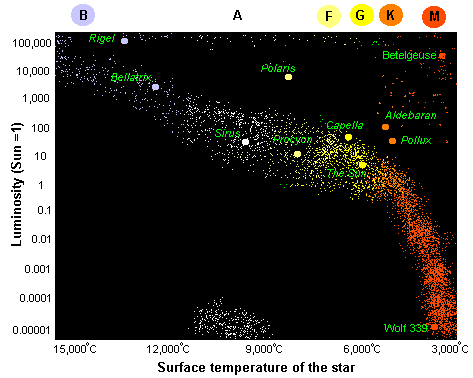 Fri Apr 25, 2003 7:01 am by Setsuna
Fri Apr 25, 2003 7:01 am by Setsuna
About the Stars... (oh man, you're gonna be kicking yourself for this one)
Basically all of the stars in the multiverse(not universe) are categorized by "The Harvard Spectral Classification", which is the most common and the simplest way to sort the stars.
OK then: There are 7 classes (marked by letters -- O, B, A, F, G, K, M), 4 sub-classes (also by letters -- R, N, S, W), and 10 "directions" (they mark the intensity/luminosity, and how close the star is to a class-caracteristic star), {marked with numbers 0-9}. All of this is used to determine where within a range of temperatures ( 35.000 K - 2.500 K {K = degrees Kelvin} ) and colors (red -- purple-blue) is a star. More about classes:
Class O : White/White-Blue stars with high surface temp.(25.000 K -- 35.000 K) usually massive and with intense luminosity. Absorption spectrums show quantities of ionized Helium, Nitrogen, and Oxygen, as well as neutral Hydrogen and Helium. Typical example -- Lambda Orionis
Class B : Blue stars with surface temperatures ranging from 15.000 to 25.000 K , similar to the O class, the absorption specters of Hydrogen and Helium are very intensive, and there are traces of absorption spectrums of ionized Calcium. Typical examples -- Riegel, Regulus
Class A : White Stars With temps. about 9.000 K on the surface, with intense Hydrogen Abs. spectrums, but no Helium Abs. spectrums, and with now more visible Calcium spectral line. Typical examples -- Sirius, Wega
Class F : Yellow-White stars somewhat more luminous than the Sun, with surface temps. about 7.000 K, have the most intense Calcium absorption spectral lines, with fading Hydrogen lines. There are also spectral lines of other metals. Typical examples -- Prokyon, Castor
Class G : Yellow stars, very similar to the Sun. Temps. on the surface are about 6.000 K, the Hydrogen lines are very weak, while the metal ones are intensifying. Typical examples -- Sun (class G2), Capella
Class K : Orange-Yellow stars with temps. ranging from 3.600 to 4.500 K. Various ionized metals are showing in the spectrograms, the strongest of which is Calcium. Hydrogen only appearing in molecular spectrums.
Typical Examples -- Pollux, Arkturus
Class M : Reddish stars, temps. 2.500 to 3.500 K. At this stage even Titanium-oxide confirms it's presence via spectrograms. Often in this class are the stars with variable luminosity.
Hydrogen is now in the Emission Spectrums. Typical stars -- Antares, Betelgez, Mira Cetti
--sub-classes--
Class R : Orange-Red stars with temp. about 3.500 K. Dominant spectrums are from molecular Carbon-Monoxide, and Dioxide, as well as Cianide. Typicall examples -- RU Virginis, S Camelopardalis
Class N : Dark Red stars with max temps. about 2.500 K, with spectrums similar to those of class R. only weaker. Typical example -- S Cephei
Class S : Similar to class M but with weaker Titanium lines, and traces of Zyrconium-Oxide. Stars in this class are very often Variable Luminosity.
Typical example -- R Cygni
Class W : The so called Wolf-Raye stars have extreme temps. on their surfaces (ranging from 50.000 to 100.000 K). Mostly Bluish, they usually have great luminosity. Wide Emission Spectrums of Carbon, Nitrogen, Oxygen and Helium are notable. Typical example -- Gamma-Yedarra
====================================================================
There are a few more things to know:
-The stars change during their "life", so if you are watching a Class A4 star, it will probably be a class N star in, say, about 2 billion years...
-Along with "Normal" stars there are also Giants and Dwarves. Density of the star plays a part in this
-There are 3 ways for a star to end it's life: become a "Grey Dwarf", a Neutron Star, or a Black Hole, depending mainly on it's mass
OK, lets sort this out...
If you have a star of enormus mass, it's gravity can squeeze itself into a tiny sphere therefore called a Dwarf. Dwarves are usually white because the pressure coming from the "squeeze" generates more fusion of the Hydrogen and thus making more heat which makes the star more luminous and shifts its color towards white (damn!). On the other hand... The massive star could develop into a giant, provided it's thermonuclear energy manages to beat the gravity and expands it. This means that the heat is more dissipated and the star cooles down, shifting it's color towards red.
When the stars Hydrogen is all used up, it cannot maintain balance beween gravity and radiation any more so there are 3 scenarios to what happens next:
If the star's mass is <= Sun's mass then the star shrinks to a white dwarf with the electromagnetic fields keeping electrons from entering the nucleus. The star gradually fades away at first turning into Yellow Dwarf, then Red, and finally Grey Dwarf stage at which it becomes something like a planet (basically a rock)
If the star's mass is 1.4 x Sun <= star <= 3 x Sun's mass then the gravity is strong enough to make the electrons and the protons to merge into neutrons. While this is in progress the helium fusions into Carbon, then the Carbon fusions int Silicium, and finally Silicium fusions into Iron, so the Neutron Star has minimum 4 layers. It also gives off a hell of a radiation...
If the star's mass is > 3 x Sun's mass then it becomes a Black Hole. To explain this, I would need about 4 times this post of space and time, so I won't do it.
If you want to know more about stars, start a topic in the off forum and ask questions one by one, I will be happy to answer them to the best of my knowledge.
BTW these are veeeery short versions of the real ones...
p.s. Don't shoot me, please...
CMPT XPBATCKOJ [